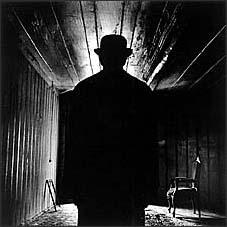 |
| "The invisible world" |
| Xosé Luis Suárez |
In the "Invisible World" we encounter three mythic representations.
The "School Teacher" by Magritte, |
 |
| "The invisible world" |
| Xosé Luis Suárez |
In the "Invisible World" we encounter three mythic representations.
The "School Teacher" by Magritte, |
The Invisible World has as a point of departure the contradiction between mankind being capable of creating happiness & well being through social, economic & cultural progress while on the other hand programming it's own destruction in order to achieve such progress. This destruction brought about by man generates at the same time a reciprocating response. Man excercises this agression on the city by making it grow out of proportion and by exploiting nature and its resources without control. The city as well as nature have ways of responding to this agression, avenging itself by creating all sorts of problems. This picture essay covers a specific area known as Galicia. It's economic problems are derived from toxic industries, an underdeveloped agriculture which leads to abandonment of fields and the corresponding urban speculation. All of that combined with massive immigration to the cities and the gradual erosion of what once was an abundant fishing industry. The visual approach to this essay stems from three characters that in my point of view share much in common and travel down the same path asking themselves similar questions. In the first place the "School teacher" by Magritte who in his meandering walks through out the city confronts an oniric world. I see in him the symbol of the oppressed , lacking in liberty, expelled through a space that increasingly will contribute to his demise. In the second place we have the sculptures by Mario Giacometti (autobiographical perhaps?), surrounded by an imaginary space and walking like unconscious automatons facing, all by themselves that empty space which we have to fill with our imagination. Emptyness and characters fight each other to impose their size, like trying to define who has more power. The last character is Sisyphus. Once again, man as a victim of himself condemned to live in suffering brought about by his own actions by defying the gods. The idea of repetition, monotony, anguish, isolation, absence of social interaction, the systematic starting all over once again is at the heart of this body of work as much as these three personages. The three, always alone, search for a way out, a solution to a situation which becomes increasingly more difficult and which cages them in this world of their own making. In the end, as Albert Camus said, this search is delineated by that space without a sky and by time without depth. Can the goal be achieved, is the question, or on the contrary will man have to start all over and do like Sisyphus, watch the rock crash towards the lower world from which he would have to start climbing up a steep hill eternally. |
| Xosé Luis Suárez |
| Xosé Luis Suárez lives and works in Vigo, Spain and can be reached at: |
| xlsuarez@uscmail.usc.es |